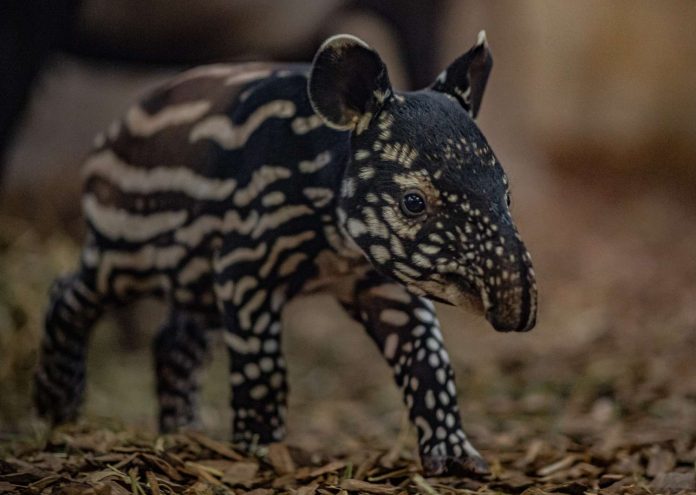A new spotted and striped Malayan tapir calf is wobbling around in Cheshire, England. Born at the Chester Zoo, the baby has been called important for the conservation of the endangered species.
Named Nessa, the female calf was born to parents Margery and Betong on Nov. 30. Following a 13-month-long pregnancy, Margery gave birth to the baby, weighing just about 20 pounds (9 kilograms).
The largest of all four tapir species, an adult Malayan tapir can weigh as much as 720 pounds (350 kilograms) and measure 6 feet (1.8 meters) long.
“We’re over the moon that Margery has delivered a healthy female calf— a birth that marks an important moment in our efforts to prevent the extinction of this wonderfully charismatic but sadly endangered species,” said Mike Jordan, director of animal and plants at the zoo.
“The Malayan tapir is a species that’s under enormous pressure—its numbers have crashed over the course of the past four decades to frighteningly low levels, with hunting and habitat destruction being the main threats to its survival.”
Also known as an Asian tapir, Asiatic tapir, and Indian tapir, this species is classified as endangered on the International Union for Conservation of Nature (IUCN) Red List of Threatened Species.
These tapirs are found only in Malaysia, Myanmar, Thailand, and the Indonesian island of Sumatra. There are just 2,500 Malayan tapirs estimated to be around today. They face threats primarily from habitat destruction and deforestation, as well as illegal hunting.
The IUCN estimates that about half the world’s population of this species was lost over the past four decades.
Spots, stripes, and long noses
Chester Zoo
Malayan tapirs communicate through a series of whistles of different pitches and duration. They’re mostly solitary, except when they get together for breeding. They are mostly active at night, but also can be spotted during the day.
They are related to both horses and rhinoceroses. When they are born, tapir calves have coats filled with spots and stripes. The distinctive pattern helps camouflage them on the forest floor. Their coats slowly change during the first six months. Then they develop black and white coats with a large white patch around their middle with black heads and hindquarters.
They have long, flexible noses that they use to forage for food. They typically have poor eyesight so they rely on strong senses of smell and hearing. Their courtship ritual involves a collection of whistling and wheezing noises.
“It’s so lovely to once again hear the pitter-patter of tiny, spotty, and stripy Malayan tapir feet. They’re really special animals, a highly endangered species and very few zoos in the whole of Britain care for them, so it’s fair to say that Nessa’s arrival has put huge smiles on all of our faces,” said Rosie Owen, a zookeeper at Chester Zoo.
“Mum Margery is ever so good with her calf. Nessa is a real bundle of energy, confident, and is often looking to explore but Marge is extremely attentive and always has a watchful eye on her. The pair of them are doing really, really well together.”

